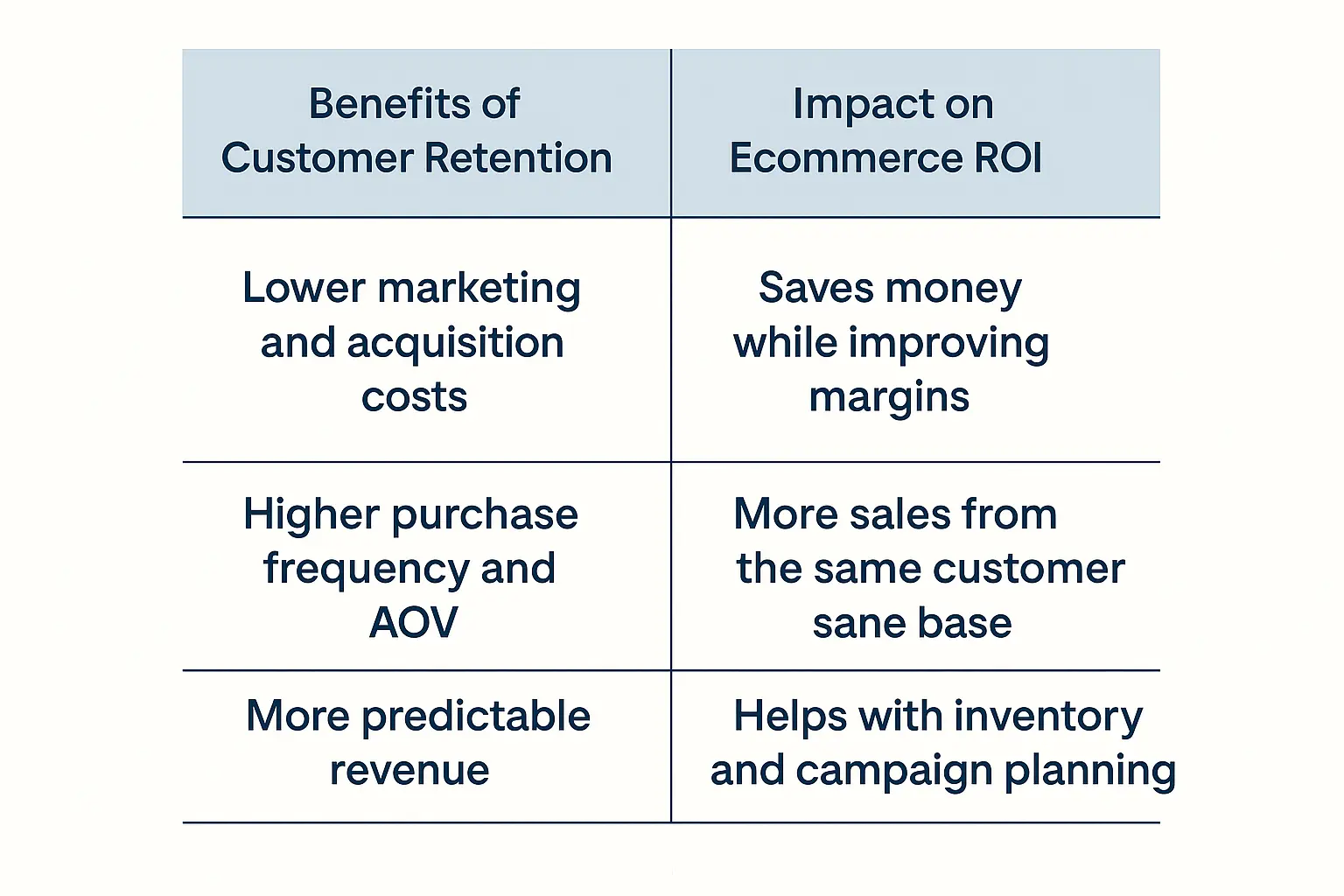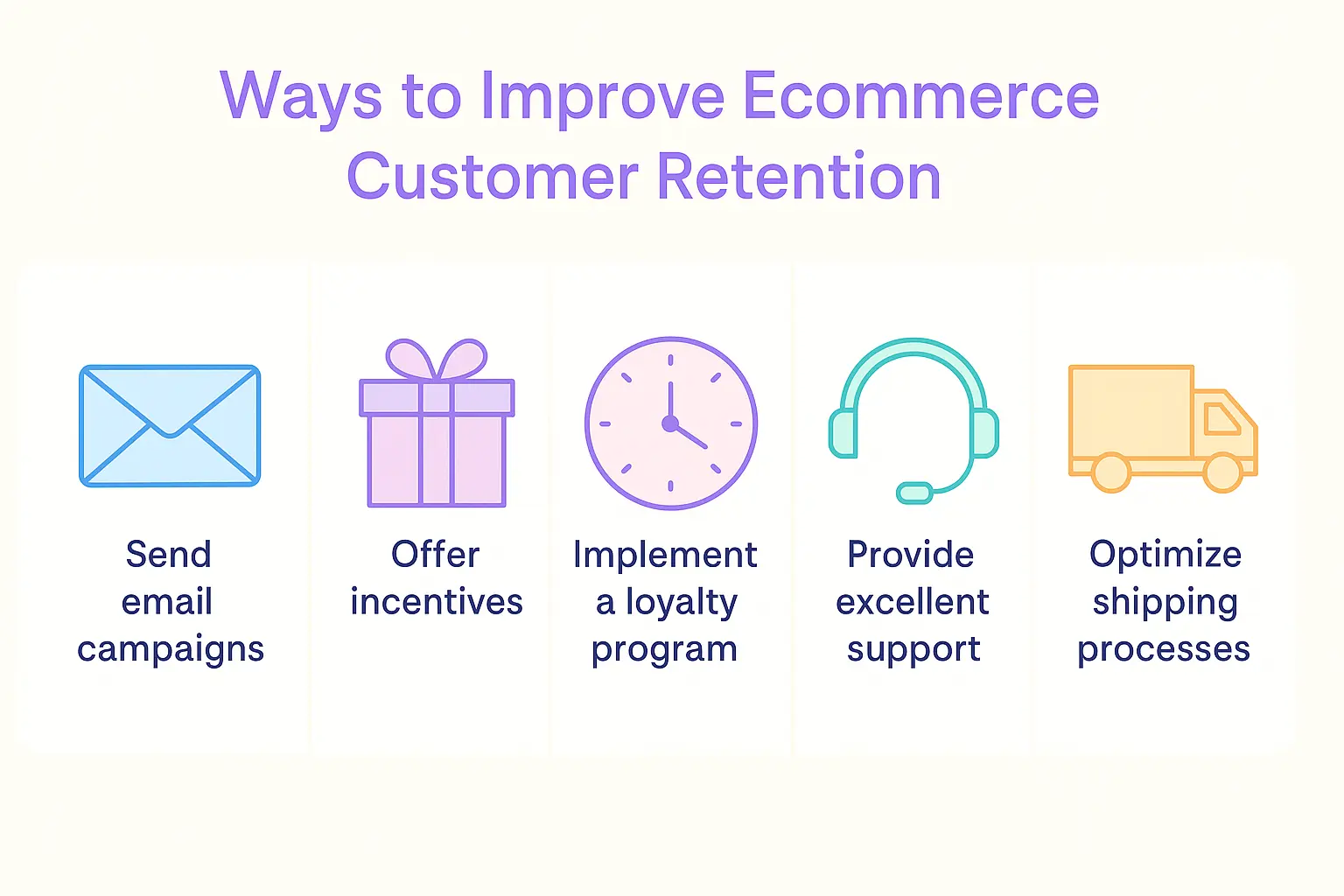In the competitive world of ecommerce, businesses that fail to prioritize customer retention risk more than just losing repeat buyers, they jeopardize long-term profitability. Acquiring new customers is significantly more expensive than keeping existing ones, yet many brands still overinvest in acquisition while neglecting the goldmine of loyalty. Studies show that boosting customer retention by just 5% can increase profits by up to 95%, thanks to more frequent purchases, higher basket sizes, and greater openness to upselling. Without a solid retention strategy, ecommerce companies suffer from erratic revenue streams, poor returns on marketing investments, and missed opportunities for cross-sells, referrals, and brand advocacy. In a landscape where loyal customers drive trust and sustainable growth, mastering retention isn’t optional—it’s essential for maximizing ROI.
Having a robust ecommerce marketing platform aids in identifying, creating, and executing the ideal ecommerce retention marketing strategy that will serve the dual purpose of retaining existing customers and steering brand perception positively.
What is Ecommerce Customer Retention?
Ecommerce customer retention is the practice of keeping your existing customers engaged and loyal to your brand so they continue making purchases over time. It’s not just about making a sale—it’s about building long-term relationships that turn one-time shoppers into lifelong buyers.
Fun Fact: Increasing retention rates by just 5% can increase profits by up to 95% (Bain & Company).
Instead of spending heavily on acquiring new customers, smart ecommerce brands focus on retention strategies that maximize the value of each customer. These efforts boost revenue, strengthen customer trust, and create reliable growth.
Why is Customer Retention Important?
Customer retention is one of the most cost-effective growth strategies in ecommerce. According to Harvard Business Review, acquiring a new customer can cost 5 to 25 times more than retaining an existing one.

Retention directly supports:
- Cost Efficiency: Repeat customers save your business on marketing and acquisition spend while delivering higher ROI. In fact, increasing customer retention by just 5% can boost profits by 25% to 95% (Bain & Company).
Example: Amazon Prime focuses heavily on retention through fast shipping, exclusive deals, and content—contributing to customer stickiness and lower churn. - Simplified Upselling and Cross-Selling: Existing customers are 50% more likely to try new products and spend 31% more per order than new ones (Invesp). They’re already familiar with your brand, reducing friction in the sales funnel.
Example: Sephora uses loyalty data to recommend products tailored to each user’s history, boosting cross-sell success. - Positive Brand Perception: Consistent engagement through personalization, loyalty programs, and smooth support experiences reinforces customer trust and emotional connection with the brand.
Example: Nike retains its community with loyalty apps, personalized content, and exclusive early access—creating a lifestyle brand perception beyond just apparel. - Competitive Advantage & Brand Affinity: In saturated markets, customer loyalty becomes a differentiator. Loyal customers refer others, leave positive reviews, and advocate for your brand—building a competitive moat over time.
Example: Starbucks’ app-based loyalty system is credited with helping them retain millions of customers and grow average customer value.

15 Effective Strategies to Boost Ecommerce Customer Retention in 2025
1. Personalized Email Marketing
Email marketing continues to reign as one of the most potent tools for engagement and ecommerce retention marketing. Its effectiveness lies in its widespread reach and ability to deliver tailored messages directly to the inboxes of potential and existing customers.
Email campaigns can enhance the overall shopping experience and drive repeat purchases if done well.
Furthermore, leveraging personalized product recommendations, tailored offers, and even enabling checkout within email campaigns can boost customer retention strategies.

By analyzing behavioral and browsing patterns, ecommerce brands can recommend products beyond mere segmentation to encompass dynamic content creation and customization to boost customer retention.
Through advanced automation and data-driven insights, marketers can dynamically generate email content that adapts to the recipient’s preferences and interactions in real-time. This dynamic approach ensures email resonates at opening, increasing the likelihood of engagement and conversion.
2. Loyalty Programs

Whether it’s through points-based systems, tiered membership levels, or exclusive access, loyalty programs encourage ongoing engagement and reward loyal customers. Investing in a well-designed, RFM-backed loyalty program strengthens customer relationships, increases brand loyalty, and drives sustainable growth over time.
3. Remarketing Campaigns
Remarketing is foremost to re-engaging customers who have previously shown interest in products or visited the website but not yet purchased.
Increase conversion and retention by targeting individuals with relevant ads across channels like search engines, social media, and display networks.
Effective remarketing campaigns consist of compelling messaging, personalized offerings, and strategic ad placements to rekindle interest and drive action.
4. Excellent Customer Service
Exceptional customer service is a cornerstone of ecommerce retention marketing strategy. In today’s highly competitive market, customers expect timely, personalized, and empathetic support from the brands they interact with.
Investing in customer service training, technology, and processes helps ecommerce businesses exceed customer expectations and build trust and loyalty.
Whether it’s through live chat, email, phone support, or social media, providing accessible and responsive customer service is a major differentiator that drives repeat business.
5. Product Recommendations
Ecommerce retention marketing is greatly improved by personalized product recommendations, which are a powerful tool for driving sales and increasing customer retention.
Analyzing customer affinities and browsing behavior helps ecommerce brands recommend relevant products that align with each customer’s preferences and interests.
Through on-site product recommendations, email campaigns, or personalized landing pages, tailored suggestions enhance the shopping experience, AOV, and repeat purchases.

6. Social Media Engagement
Social media provides a unique opportunity for ecommerce retention marketing by connecting with the audience on a more personal level.
Effective customer retention involves listening to customer feedback, responding promptly, sharing valuable content, and participating in relevant conversations.
Humanizing your brand and creating authentic connections strengthens customer relationships, drives long-term engagement and strengthens your customer retention strategy.
7. Exclusive Offers for Existing Customers
Offering exclusive deals, discounts, or promotions to existing customers can make them feel valued and appreciated.
Ecommerce businesses can strengthen customer relationships and encourage ongoing engagement by rewarding loyalty and incentivizing repeat purchases.

Exclusive offers can take various forms, such as early access to sales, VIP events, birthday discounts, or referral bonuses. Make customers feel special for their loyalty, encouraging them to continue shopping and advocate for your brand.
8. Simplified Checkout Process
A streamlined checkout process can significantly impact customer retention and conversion rates. A complicated or lengthy checkout process can frustrate customers and lead to cart abandonment. This results in lost sales and missed opportunities, which can wreak havoc on your customer retention strategy.

Optimizing their checkout flow and removing unnecessary steps, form fields, and distractions improves the overall shopping experience and conversion rates.
Offering guest checkout options, pre-filling form fields, and providing multiple payment methods enhances the checkout experience and simplifies the purchase.
9. Customer Feedback and Surveys

Gathering feedback from customers is essential for understanding their needs, preferences, and pain points. By soliciting feedback through surveys, polls, or feedback forms, ecommerce businesses can gather valuable insights into customer satisfaction, product preferences, and areas for improvement, a valuable source to craft ecommerce retention strategies.
Analyzing customer feedback helps identify trends, address common issues, and make data-driven decisions. This improves the overall customer experience, leading to a robust ecommerce retention marketing strategy.
Additionally, actively listening to customer feedback and responding promptly demonstrates a commitment to customer satisfaction, the basis for a sound customer retention strategy.
10. Personalized Product Communications
Personalized product communication based on past purchase history, browsing behavior, or demographic information can significantly impact ecommerce retention and sales.
Leveraging data-driven recommendation engines helps ecommerce businesses deliver relevant and timely suggestions with catalog updates that resonate with customers.

Whether it’s through personalized email campaigns, SMS, WhatsApp, or any preferred channel, offering tailored product recommendations alongside updates on price drops and availability can enhance the shopping experience and increase engagement, ultimately driving repeat purchases and improving your ecommerce retention marketing strategy.
11. Gamification
For stellar ecommerce retention marketing, introducing elements of gamification into the shopping experience can make it more engaging and enjoyable for customers.
By incorporating game-like features such as rewards, challenges, badges, or leaderboards, ecommerce businesses can incentivize desired behaviors, encourage repeat purchases, and increase customer loyalty.
Gamification can take various forms, such as loyalty point systems, progress bars, or interactive quizzes and contests. Make the experience fun, interactive, and rewarding for customers while also aligning with your brand values and objectives.

12. AI-Driven Personalization
Harnessing the power of artificial intelligence (AI) for personalized customer experiences can significantly impact ecommerce retention marketing.
Leverage AI-powered analytics on customer affinities, including browsing behavior, purchase history, and preferences, to predict and recommend products tailored to individual customers.

Implementing AI-driven personalization across platforms, from website interactions to email campaigns, not only enhances the customer shopping experience but also increases the likelihood of repeat purchases.
By adapting to customer behaviors, AI creates a dynamic, engaging journey, fostering lasting connections between customers and e-commerce businesses.
13. User-generated Content
Encouraging customers to create and share user-generated content, such as reviews, testimonials, photos, or videos helps ecommerce businesses build trust and credibility with their audience.
User-generated content provides social proof and authenticates the quality and value of your products or services, influencing purchase decisions and building brand loyalty. Incentivizing customers to share experiences boosts ecommerce retention strategies, amplifies reach, fosters community, and drives engagement.
Whether it’s through branded hashtags, customer contests, or product review campaigns, leveraging user-generated content can strengthen your brand reputation and create a sense of belonging among your customers.
14. Post-Purchase Follow-ups
Following up with customers after their purchase is a crucial step in the customer journey and is crucial for effective ecommerce retention marketing. Whether it’s a thank-you email, a request for feedback, or a special offer for their next purchase, post-purchase follow-ups provide an opportunity to connect with customers, show appreciation for their business, and encourage repeat business.

Ecommerce businesses can nurture relationships, address any concerns or issues promptly, and provide additional value beyond the initial purchase by staying top-of-mind and maintaining ongoing communication with customers.
Post-purchase follow-ups can also help gather feedback on the shopping experience, product quality, or delivery process, allowing businesses to make improvements and enhance customer satisfaction over time.
15. Continuous Improvement
Ecommerce retention marketing is an ongoing process that requires continuous evaluation and improvement. Ecommerce businesses should regularly monitor key metrics such as customer retention rate, churn rate, and lifetime value to gauge the effectiveness of their retention strategies.
By analyzing data, gathering feedback, and following industry trends, businesses can identify improvement areas and optimize for long-term success.
It’s essential to adapt and evolve your customer retention strategies based on changing customer preferences, market dynamics, and competitive landscape to stay ahead of the curve and maintain a loyal customer base.
Customer retention has evolved into the latest strategy for acquisition
In conclusion, ecommerce retention marketing is a critical aspect of ecommerce that requires strategic planning, consistent effort, and a customer-centric approach.
Personalized emails, loyalty programs, social media engagement, and user-generated content are key tactics to retain customers and build loyalty. Prioritizing customer retention and customer satisfaction helps ecommerce businesses will stand out, drive repeat business, and achieve long-term success.
Incorporating these strategies can enhance customer satisfaction, drive repeat purchases, and ultimately increase ecommerce revenue and profitability.
Ready to build lasting customer relationships and boost your bottom line?
Book a personalized demo with our retention experts to get a tailored strategy curated specifically for your ecommerce business and start turning one-time buyers into lifelong customers.








